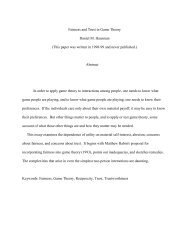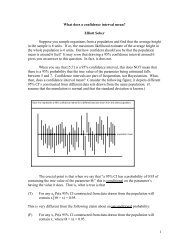Counterexamples to a Likelihood Theory of Evidence
Counterexamples to a Likelihood Theory of Evidence
Counterexamples to a Likelihood Theory of Evidence
You also want an ePaper? Increase the reach of your titles
YUMPU automatically turns print PDFs into web optimized ePapers that Google loves.
coefficients ensures that the variances <strong>of</strong> X and Y in the data are the same when the dataare clustered around X = −10 and X = +10, as shown in Fig. 5. With respect <strong>to</strong> the singleclustereddata (Fig. 3), the likelihood functions <strong>of</strong> models F and B are not equal. But,with respect <strong>to</strong> the data in Fig. 5, the maximum likelihoods <strong>of</strong> each model are now thesame, which means that the likelihood <strong>of</strong> any hypothesis in one model can be matched bythe likelihood <strong>of</strong> a hypothesis in the other model (see the Appendix for the pro<strong>of</strong>). Inother words, the two models are equally good at accommodating the <strong>to</strong>tal data. But theyare predictively very different, as we are about <strong>to</strong> show.To complete the argument, we need only explain how the data (in Fig. 4) tell uswhich model is true. One way would be <strong>to</strong> show that every hypothesis in B is false byplotting the residuals, as explained in Example 2. But there is an easier way…The idea is <strong>to</strong> fit each model <strong>to</strong> the two clusters <strong>of</strong> data separately and comparethe independent estimates <strong>of</strong> the parameters obtained from the best fitting curves. I willdescribe this in a way that is reminiscent <strong>of</strong> the “test <strong>of</strong> hypotheses” that WilliamWhewell called the consilience <strong>of</strong> inductions (Whewell 1858, 1989). Let X1and Y1refer<strong>to</strong> the cluster <strong>of</strong> data on the lower left <strong>of</strong> Fig. 5, while X2and Y2refer <strong>to</strong> the cluster onthe upper right. Then F can be rewritten in terms <strong>of</strong> two s<strong>to</strong>chastic equations,Y1 = α1+ β1X1+ σU1, and Y2 = α2 + β2X2 + σU2, plus two constraints α1 = α2andβ1 = β2. 13 The two s<strong>to</strong>chastic equations are not rival models; they are parts <strong>of</strong> the samemodel (let’s call them submodels). This way <strong>of</strong> writing the model makes no essentialchanges—it is just a different way <strong>of</strong> describing the same family <strong>of</strong> probabilitydistributions. If we fit the submodels <strong>to</strong> their respective clusters <strong>of</strong> data, we obtainindependent estimates <strong>of</strong> the parameters from the best fitting lines, which we can then use<strong>to</strong> test the constraints.The results will be as follows. Using the data in Fig. 5, the independentmeasurements <strong>of</strong> the F parameters will agree closely (by any statistical criterion). Butthe B model will fail the same test. To see this, rewrite B as X1 = a1+ bY1 1+ sV1, andX2= a2 + bY2 2+ sV2, plus the constraints a1 = a2and b1 = b2. The constraintb1= b 2will beverified, but the constraint a1 = a2is not close <strong>to</strong> being true. As shown in Fig. 5, theestimated values are approximately a1= − 10 and a2= + 10 . No statistical analysis canconclude that these are independent measurements <strong>of</strong> a single quantity. The data showsplainly that B is the false model, and therefore LTE is false.To put the point another way, B is false because it fails <strong>to</strong> predict features <strong>of</strong> onecluster <strong>of</strong> data from the rest <strong>of</strong> the data. When we fit B <strong>to</strong> the lower data cluster, we get abackwards regression curve that approximates the line Y = − 10 + 2X (the steep line onthe left in Fig. 5). Recall from Example 1, and Fig. 3, that this is the line from which Bcould have generated the lower data without us being able <strong>to</strong> tell. But we can tell that itdid not generate the upper cluster <strong>of</strong> data—because the line does not pass anywhere nearthe points in the upper right quadrant. B fails at this kind <strong>of</strong> cross-situational invariance(Forster, 1984), even though it is able <strong>to</strong> accommodate the full data perfectly well. The13 The word ‘constraint’ is borrowed from Sneed (1971), who introduced it as a way <strong>of</strong> constrainingsubmodels. Although the sense <strong>of</strong> ‘model’ assumed here is different from Sneed’s, the idea is the same.16




